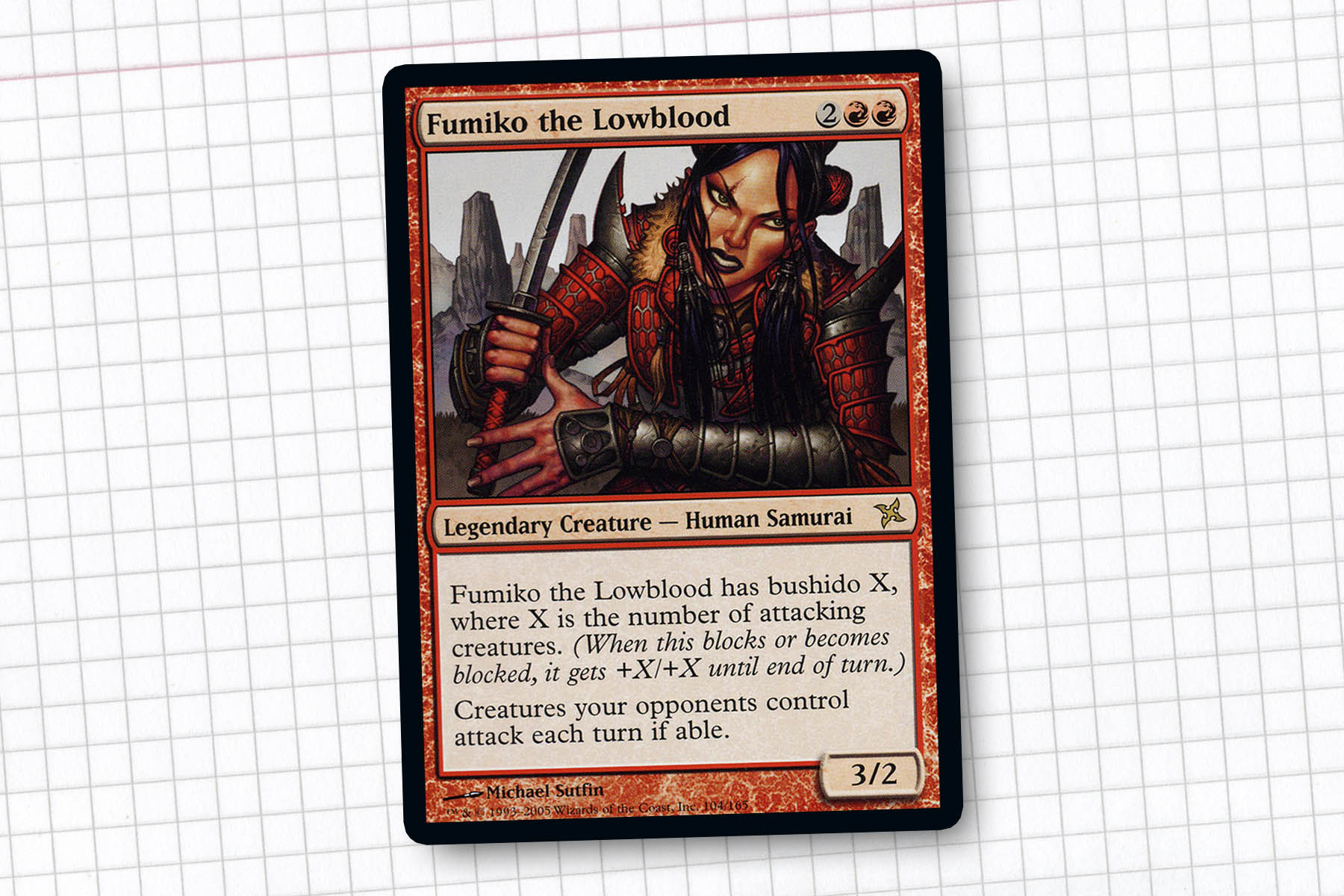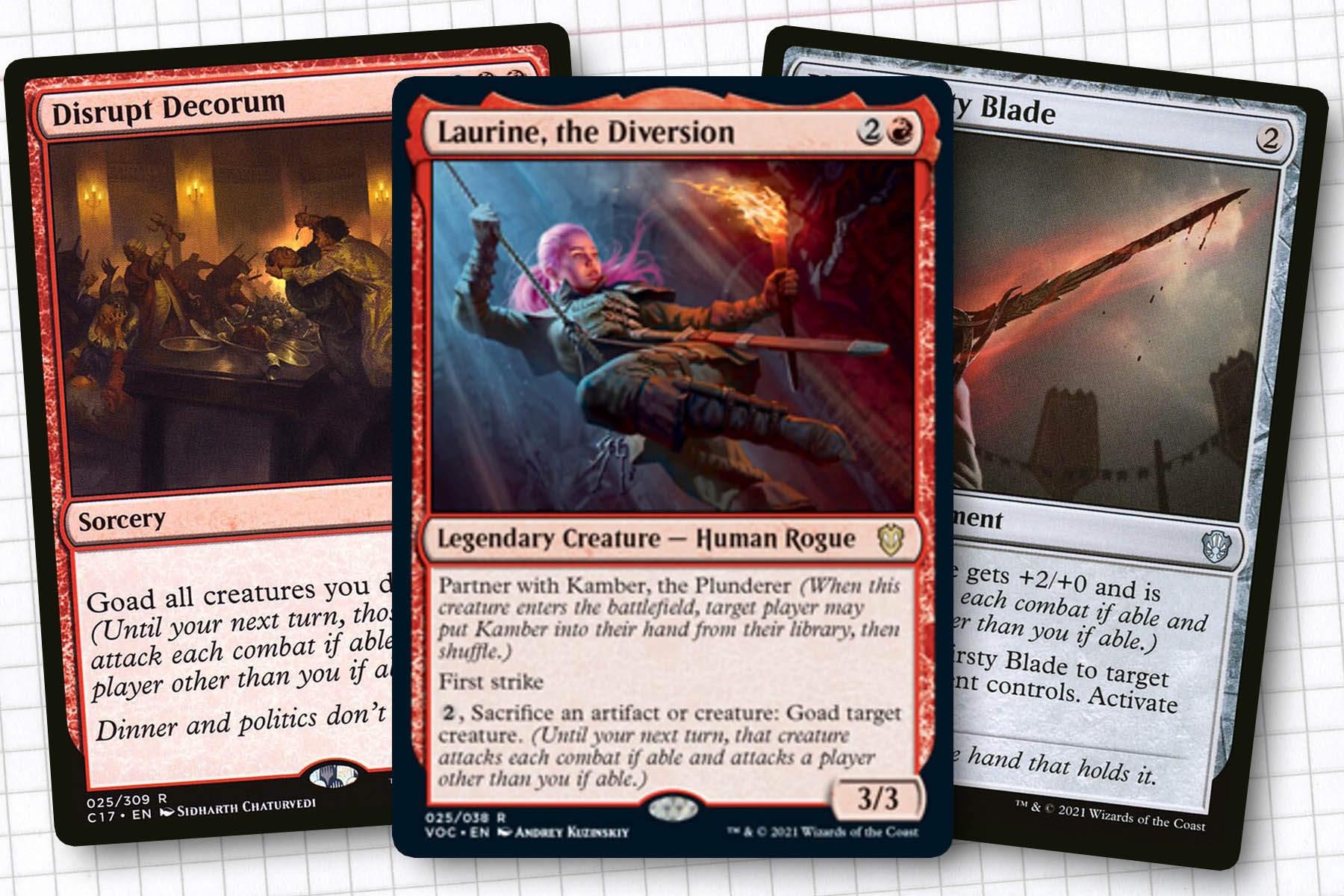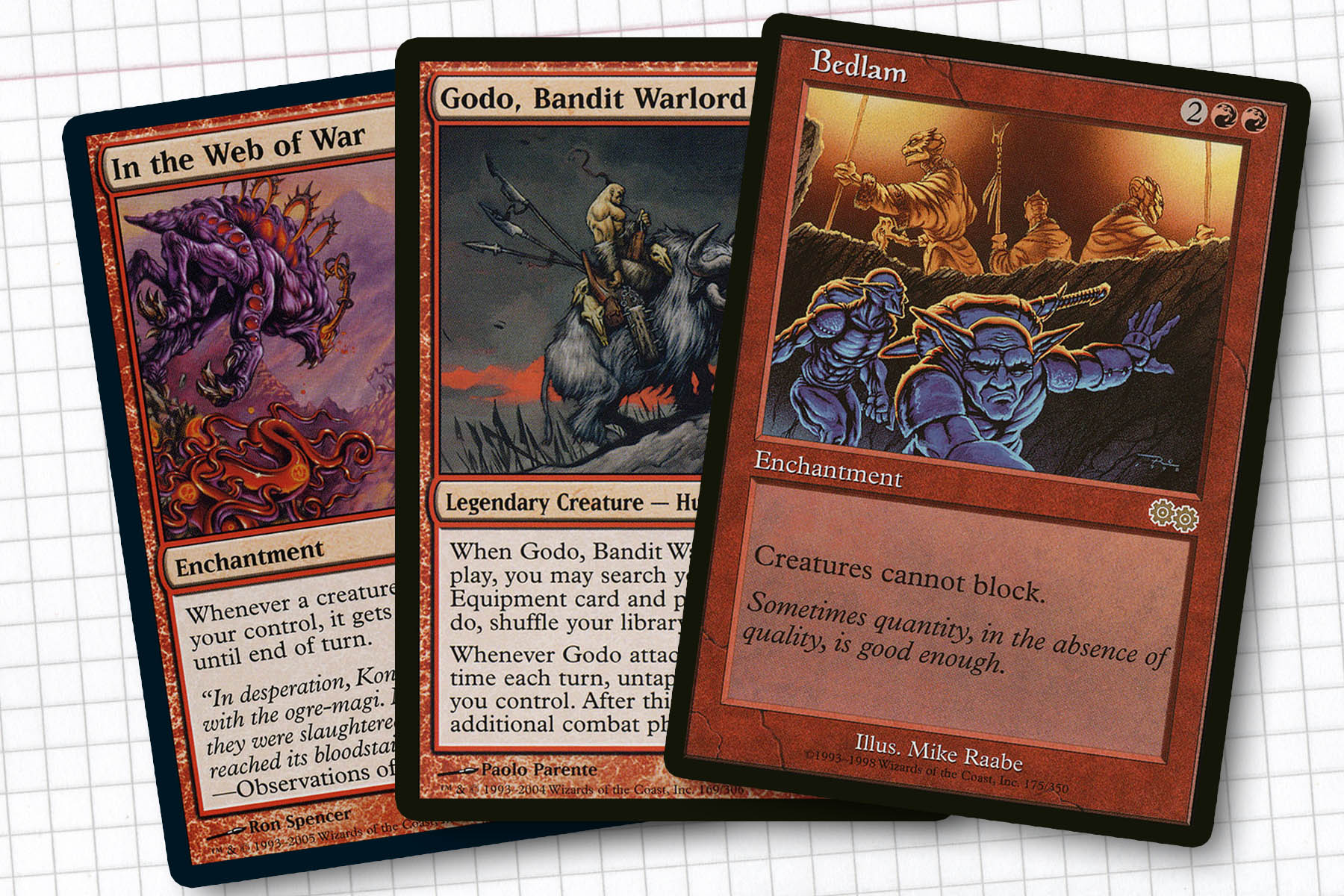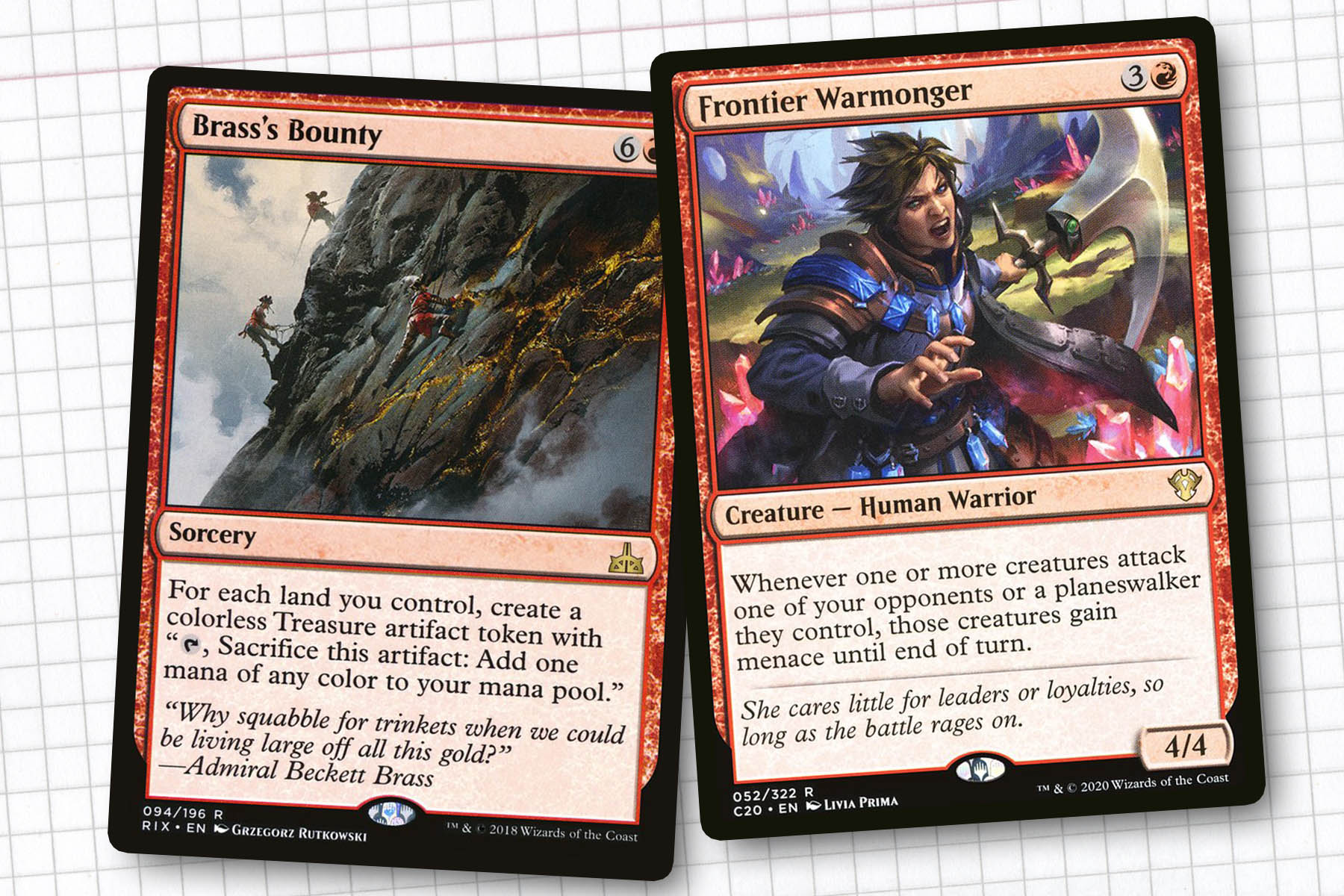As a long time fan of the Kamigawa block, I knew that in the lead up to Kamigawa Neon Dynasty I wanted to really put a spotlight on the plane. My connection is admittedly based in nostalgia, but the block came along at the right time in my life that it made an extremely strong impact. The world is deep in its references and is extremely top-down, to the point where a casual viewer will not get the references. I do not get a lot of the references. But a fantasy game going to this starkly different Japanese-inspired plane, with this rich tapestry of humans, spirits, samurai and shrines, it played into so many of the things that I loved growing up reading Shonen Jump and watching Shaman King.
Even in the cards, I can look at the Kamigawa block 20 years later and see the shortcomings. There is an obvious power level disparity with Mirrodin and Ravnica existed on either side of it. But I found so many of the characters engrossing and the literature that accompanied the block only made those characters come alive. Last time, I started a series of articles revisiting monocolored generals from Kamigawa, with Tetsuo Umezawa to start. This week, we will be highlighting a legendary creature that unfortunately did not have a place in the books and never got backstory, a huge personal letdown in the lore. Nevertheless, I am excited to talk about Fumiko the Lowblood.
We are mining the raw power of red’s early color pie, the recent developments, and a pet mechanic of mine, all to create a political deck capable of turning the tide of battle in our favor. Let’s not waste another moment.
Commander: Fumiko the Lowblood
Creatures: Agitator Ant, Avatar of Slaughter, Bladegriff Prototype, Emberwilde Captain, Frenzied Saddlebrute, Frontier Warmonger, Geode Rager, Goblin Racketeer, Goblin Spymaster, Godo, Bandit Warlord, Grenzo, Havoc Raiser, Kazuul, Tyrant of the Cliffs, Laurine, the Diversion, Maelstrom Colossus, Skyline Despot, Terror of Mount Velus, Varchild, Betrayer of Kjeldor, Vengeful Ancestor, Wrecking Ogre, Wurmcoil Engine
Artifacts: Bag of Holding, Bloodthirsty Blade, Butcher’s Cleaver, Echo Circlet, Endless Atlas, Fire Diamond, Gilded Lotus, God-Pharaoh’s Gift, Hazoret’s Monument, Heraldic Banner, Meteoric Mace, Mind Stone, Oathkeeper, Takeno’s Daisho, Ruby Medallion, Sisay’s Ring, Sol Ring, Tenza, Godo’s Maul, Thran Dynamo
Enchantments: Bedlam, Court of Ire, Curse of Opulence, In the Web of War, Magistrate’s Veto, Mass Hysteria, Rage Reflection, Retreat to Valakut, Rite of the Raging Storm, Share the Spoils, Shiny Impetus, War Cadence, Warstorm Surge
Instants: Act of Aggression, Unexpected Windfall
Sorceries: Besmirch, Bond of Passion, Brass’s Bounty, Claim the Firstborn, Disrupt Decorum, Mizzium Mortars, Strike It Rich, Vandalblast
Lands: 32 Mountain, Castle Embereth, Ghost Quarter, Mikokoro, Center of the Sea, Myriad Landscape, War Room, Witch’s Clinic

Fumiko the Lowblood has interested me ever since first seeing it so long ago. I didn’t get my reps in with her until the original Ravnica block was rolling out and I was deep into lunch table Magic with multiple players as my core experience. The variable bushido felt like a deterrent that complimented her second ability, which forces creature interaction.
Periodically, I have looked at Fumiko as an ample commander for some kind of kamikaze strategy. But honestly, finding the core of this deck wasn’t a simple task. The plan had always been to have her attack beside a bunch of other creatures, using Grappling Hook and Loxodon Warhammer to force one creature to block her and trample the remaining damage.
But as we will soon get into, I realized that it would be a lot easier to manipulate combat so that the creatures I am forcing to attack simply go elsewhere and my other creatures can attack my target unfettered. This would leave Fumiko safely on defense, able to block any creatures I might not be able to sway elsewhere, while also separating what the deck was doing from entirely being reliant on Fumiko.

Goaded to Combat
Goad has been on my radar since we first saw it in Conspiracy: Take the Crown; it’s a brilliant mechanic that pushes interaction. It’s something I wish I’d had around all those years ago playing lunch table Magic. The only issue I had for the longest time was a perception that it hadn’t been used enough to make a strong theme for a deck. I can now confidently say that we have enough sources that even in a monocolored deck, it can make a proper appearance now.
Repeatable goad in the form of Bloodthirsty Blade, Geode Rager, Laurine, the Diversion, and Vengeful Ancestor means that we can play closer to aikido strategy, using our opponent’s strengths as our own.
Of all of the goad effects in this deck, none is more widely played than Disrupt Decorum, which is staple-tier in Commander. The card is really emblematic of what I was hoping to achieve with this deck, creating a long list of decision points for our opponents, without having the hate coming our way. Then there is Grenzo, Havoc Raiser, who pulls double duty either goading creatures into combat or giving us access to the defending player’s spells. Once again highlighting the aikido nature of the deck.
I had overlooked Agitator Ant, mostly because it reminded me too much of Orzhov Advokist, which acted more like a stalling tactic than combat manipulation. But adding goad to the effect really changes how it plays out. If Fumiko is out, players already have to attack, so they may feel that having a bigger creature may result in them losing less of their creature base turn after turn. The exact kind of forced decision making I am hoping to push every game.

Respecting the Past
Monocolored decks are certainly not my strong suit, but one of the perks is that you get to test out cards you may not consider in a typical initial draft. When looking at the early red color pie, there is room to use some of the wacky enchantments. Since we are trying to dictate the flow of combat, we have Bedlam, Magistrate’s Veto, and War Cadence on hand to make sure that our opponents’ goaded creatures don’t have easy outs to be chump blocked. The theory being that if everyone is alpha striking each other, the game won’t go on too long and we will not expend our resources and allow our opponents to start choosing to attack us.
A tenet of the deck is that we should always be attacking; this is made easier by the fact that our opponents have no choice in the matter of if they will be attacking. My hope is that while our opponents will be encumbered by our enchantments, we should be able to have agency through cards such as In the Web of War, Mass Hysteria, and Warstorm Surge, allowing us to attack on the regular or at least dish out some damage with every new creature.
Lastly, I feel the need to discuss Godo, Bandit Warlord a little bit, as we don’t have a large amount of equipment and samurai in the deck. In my mind, having Stoneforge Mystic at the ready in this deck is a boon. The floor on Godo is grabbing our copy of Bloodthirsty Blade to start goading a problem creature, and the ceiling is grabbing Oathkeeper, Takeno’s Daisho to protect Fumiko from wrath effects. An extra attack if Fumiko has trigger bushido is certainly nice, but I would not personally value Godo solely for that trigger.

The New Red Color Pie
Red has grown a lot with the addition of treasure tokens in the last five years. The ability for them to have access to more outlets for mana creation, which we used to only see in their ritual effects, means that we can build up to more explosive turns. Brass’s Bounty, Curse of Opulence, Shiny Impetus, and Unexpected Windfall all inject treasure into our game plan and, in most cases, play into the general direction of our strategy.
Since I do not focus on monocolored decks on the regular, I often find cards that have gone overlooked, because they have a comparable game piece in another color, as much as eighteen months after their first printing. Looking at cards that have come out in the last year, I was very impressed by Court of Ire, Frenzied Saddlebrute, and Frontier Warmonger. Obviously, players can opt out of attacking my opponents, but when doing so grants haste and menace, we are strongly influencing the flow of combat. Lastly, Hazoret’s Monument (along with the rest of the cycle) is such a great role player that I feel gets overlooked. Not only do Monuments lower the cost of your creature spells, but they give you tangible benefits when cast creatures and in the deck, access to rummaging.
Closing Thoughts
When drawing up plans for this Kamigawa series, I had not originally thought about Fumiko. This deck had always been something that I kept in the back of my mind, but as I stated earlier, the idea never solidified into something tangible for me.
I am really happy with where this deck is at this point, to say that you want to have a combat-focused red deck is not immensely original and I didn’t want to commit time to an idea that could have easily been replaced with a different general and not feel different. Goad amplifies what Fumiko already wants to do and, in my opinion, allows her to finally feel like a fully realized idea.
Next time, we’re going to explore a tribe that I really want to see fleshed out further in Neon Dynasty: snakes. The snakes of Kamigawa are so unique and while the power level may be lower, the Vorthos energy will be strong. I really hope you join me then.
Ryan Sainio is a Graphic Designer who writes about EDH and the EDH community. He has been playing Magic: the Gathering since 7th Edition in 2002 and values flavorful and fun gameplay over competitively optimized decks.



